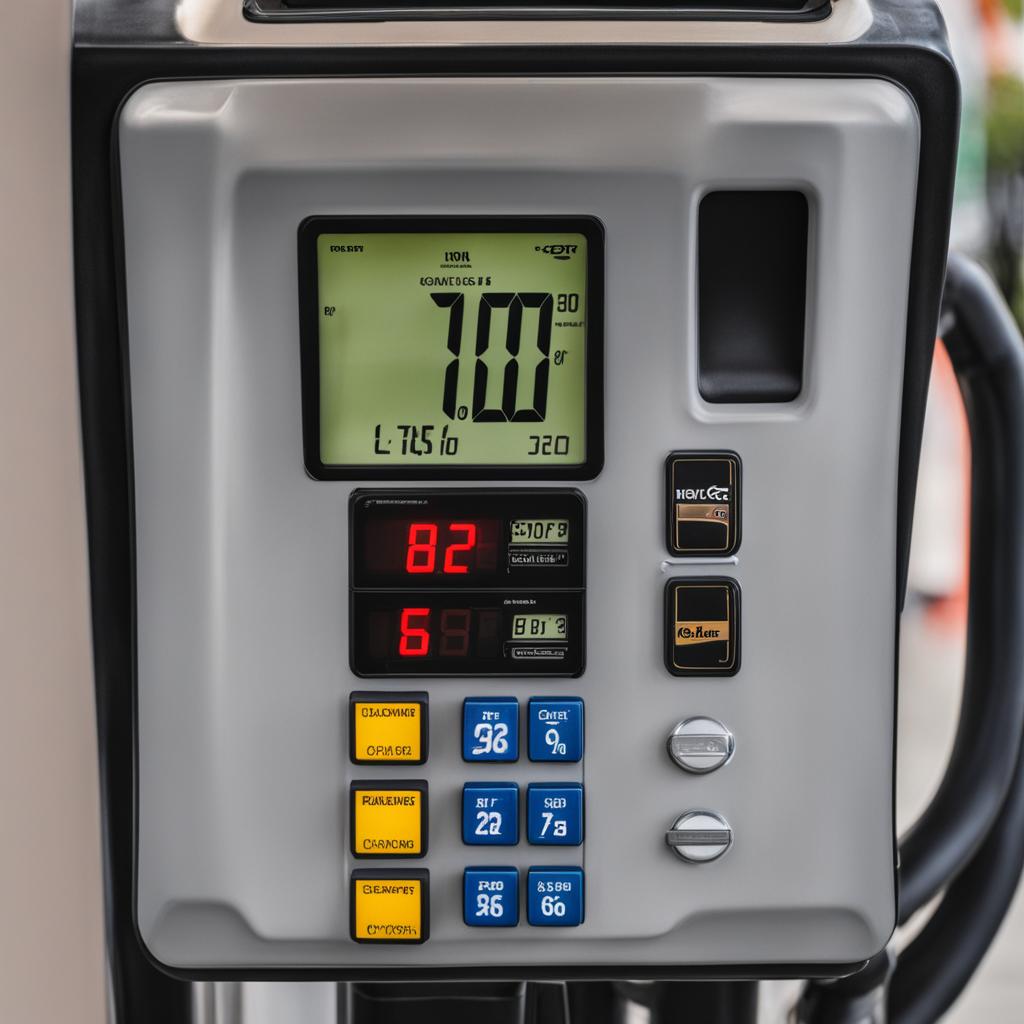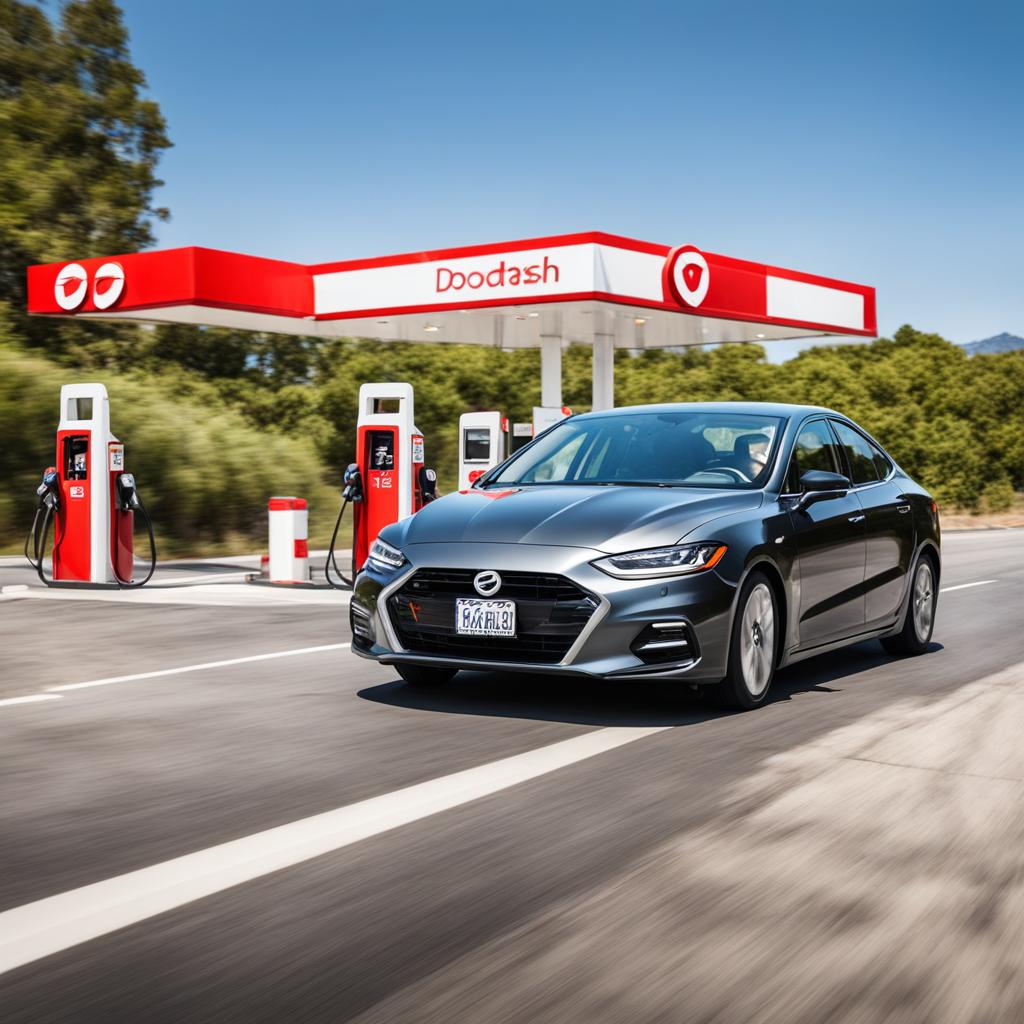As a DoorDash driver, one of the expenses you may be concerned about is gas. After all, delivering orders can rack up mileage and fuel costs. In this article, I’ll provide you with all the information you need to know about DoorDash’s gas payment policy and how it affects drivers like you.
First and foremost, it’s important to note that DoorDash does not directly reimburse drivers for their gas expenses. This applies not just to DoorDash, but also to other popular delivery services like Uber Eats, Instacart, Grubhub, and Shipt. However, DoorDash has implemented a Gas Rewards program to help offset the rising cost of fuel for its Dashers.
Key Takeaways:
- DoorDash does not provide direct reimbursement for gas expenses to its drivers.
- DoorDash’s Gas Rewards program offers a 10% cash back on gas for Dashers who use their DasherDirect card.
- High-mileage Dashers can also benefit from a weekly gas bonus.
- DoorDash drivers can save money on gas by tracking mileage and potentially deducting expenses at tax time.
- While gas expenses are not covered by DoorDash, the flexibility and earning opportunities can still make delivering for the company worthwhile.
How Does DoorDash Pay Its Drivers?
When it comes to payment, DoorDash has a unique model for compensating its drivers. Instead of a fixed hourly rate or salary, Dashers are paid on a per-order basis. Let’s take a closer look at the components of DoorDash’s payment model:
Base Pay
At the core of DoorDash’s payment structure is the base pay, which varies depending on several factors. This includes elements such as the time it takes to complete the delivery, the distance traveled, and the desirability of the order. Base pay typically ranges from $2 to $10 per order. The table below illustrates the breakdown of base pay for different order scenarios.
| Order Scenario | Base Pay Range |
|---|---|
| Short distance, low-demand order | $2 – $4 |
| Moderate distance, average-demand order | $4 – $7 |
| Long distance, high-demand order | $7 – $10 |
Promotions
In addition to base pay, DoorDash offers promotions that allow Dashers to earn extra income. One such promotion is Peak Pay, which provides additional earnings on top of the base pay during busy times. Dashers can take advantage of the high demand and earn more for their deliveries. Another promotion is Challenges, where Dashers can earn bonuses for completing a certain number of deliveries within a specific timeframe. These promotions incentivize Dashers to complete more orders and maximize their earnings.
Tips
DoorDash also allows customers to tip their drivers through the app. Dashers keep 100% of the tips, which can significantly boost their overall income. Encouraging customers to tip generously is not only a way to show appreciation for excellent service but also a way for Dashers to earn more for their hard work and dedication, emphasizing the importance of providing exceptional service to customers.
In summary, DoorDash pays its drivers based on a per-order payment model. Drivers receive a base pay that varies depending on factors such as time, distance, and order desirability. Dashers can also earn additional income through promotions like Peak Pay and Challenges. Furthermore, Dashers keep 100% of the tips they receive, providing an opportunity to increase their overall earnings. The combination of base pay, promotions, and tips allows DoorDash drivers the potential to earn a competitive income while providing a valuable service to customers.
Why Doesn’t DoorDash Pay for Gas?
One of the main reasons DoorDash does not pay for gas is because Dashers are classified as independent contractors, not employees. This distinction affects the compensation structure and expenses covered by the company. In DoorDash’s Independent Contractor Agreement (ICA), Dashers are responsible for providing and maintaining their own equipment, including vehicles.
The agreement specifies that Dashers bear all costs and expenses related to their performance of contracted services, including gas expenses. While this may seem like a disadvantage, being classified as an independent contractor also allows Dashers to take advantage of certain tax deductions related to their business expenses.
As independent contractors, Dashers have more control over their working arrangements and can deduct business expenses when filing their taxes. This includes deductions for gas expenses incurred while making deliveries for DoorDash. Keeping track of mileage and gas expenses becomes crucial for maximizing deductions and reducing overall tax liability.
Advantages of Being an Independent Contractor
While DoorDash not paying for gas expenses can be a drawback, there are several advantages to being classified as an independent contractor. Some of these advantages include:
- Flexibility in setting your own schedule
- Ability to work for multiple delivery services
- Potential for higher earnings through bonuses and incentives
- Tax deductions for business expenses, including gas costs
Being an independent contractor offers Dashers the freedom to work on their own terms and take advantage of the tax benefits available to them. By carefully managing expenses and maximizing deductions, Dashers can offset the cost of gas and potentially increase their overall earnings.
| Dasher Status | Gas Expense Responsibility |
|---|---|
| Independent Contractor | Dasher is responsible for all gas expenses |
| Employee | Company may reimburse gas expenses |
In DoorDash’s Independent Contractor Agreement (ICA), it clearly states: “You bear all costs and expenses incurred in connection with the performance of the contracted services, including, but not limited to, the cost of gasoline or other fuel.”
Dashers should keep accurate records of their gas expenses, including receipts and mileage logs, to substantiate their deductions and ensure compliance with tax regulations. By maintaining good financial records and staying informed about the tax rules that apply to independent contractors, Dashers can minimize their expenses and maximize their earnings.
How to Take Tax Deductions for Gas as a Dasher
As independent contractors, DoorDash drivers have the opportunity to deduct their gas expenses come tax time. There are two primary methods for taking tax deductions specifically for gas as a Dasher.
Federal Standard Reimbursement for Mileage
The first method involves the federal standard reimbursement for mileage, which is set by the IRS at a specific rate per mile. For the year 2024, the standard mileage deduction is 62.5 cents per mile. This rate increases to 65.5 cents per mile in 2024. This deduction covers all expenses related to driving for DoorDash, including gas costs.
Deducting Actual Expenses
The second method for tax deductions is deducting actual expenses. Dashers can keep track of and deduct the specific costs they incur for gas, maintenance, tolls, parking fees, and other delivery-related expenses. This method allows for more precise deductions but requires meticulous record-keeping to ensure accuracy.
Determining which method is most beneficial depends on individual circumstances. Some Dashers may find that the federal standard reimbursement offers the most significant deduction, while others may opt for deducting actual expenses to maximize their deductions.

By taking advantage of tax deductions for gas, Dashers can save on overall expenses and potentially reduce their taxable income, resulting in a lower tax liability.
Tips for DoorDash Drivers to Save Money on Gas
As a DoorDash driver, there are several strategies you can implement to save money on gas while making deliveries. By taking advantage of these tips, you can reduce your expenses and maximize your earnings. Here are some valuable suggestions:
1. Drive a Fuel-Efficient Car
Consider using a fuel-efficient car for your deliveries. These vehicles have higher mileage per gallon, which helps reduce your overall fuel costs. By choosing a car that consumes less fuel, you can save money on gas and increase your profits.
2. Track Your Mileage
Keeping track of your mileage is crucial in maximizing your deductions at tax time. Accurate mileage tracking allows you to claim expenses related to your deliveries, including gas costs. You can use a mileage tracking app or manually record your mileage to ensure you don’t miss out on potential deductions.
3. Cash Back Gas Cards
Consider getting a cash back gas card to further save on fuel expenses. One excellent option for DoorDash drivers is the DasherDirect card. This card offers 10% cash back on gas purchases, allowing you to earn rewards while filling up your tank. Taking advantage of cash back offers can help offset your gas costs in the long run.
4. Busy Times for Deliveries
During peak delivery times when the DoorDash app is busy, you can increase your earnings and help offset gas expenses. By strategically planning your deliveries during high-demand periods, you have the opportunity to complete more orders in less time, maximizing your income. Keep an eye on the app and take advantage of busy periods to make the most of your driving hours.
By implementing these tips and making smart choices, you can save money on gas as a DoorDash driver. Remember to drive a fuel-efficient car, track your mileage accurately, consider cash back gas cards, and take advantage of busy times for deliveries. With these strategies in place, you can maximize your earnings and reduce your overall expenses.
Does DoorDash Pay More for Longer Deliveries?
DoorDash’s pay model takes distance into account when calculating base pay for deliveries. While the exact criteria for longer deliveries are not specified, Dashers can expect a higher base pay for orders that involve greater distances or are considered more difficult or desirable. The decision to accept longer deliveries should be based on factors such as gas costs and potential earnings, considering the mileage reimbursement and potential tips for the order.

Understanding how DoorDash pays for longer deliveries is crucial for Dashers looking to maximize their earnings. The company recognizes the additional time, effort, and distance involved in these orders and compensates Dashers accordingly. By offering a higher base pay, DoorDash acknowledges the challenges that come with longer deliveries and aims to provide fair compensation for their efforts.
When considering whether to accept longer deliveries, it’s essential for Dashers to weigh the potential benefits against the associated costs. While longer deliveries offer higher base pay, drivers should keep in mind the impact on gas expenses. Factors such as the reimbursement rate per mile, potential tips, and other expenses should all be considered in the decision-making process.
It’s important to note that DoorDash’s pay structure, including base pay and potential tips, can vary based on multiple factors. These factors include distance, desirability, time, and other considerations specific to each order. DoorDash aims to incentivize Dashers to accept longer deliveries by offering higher base pay, which helps offset the additional time and distance required.
| Factors Considered for Base Pay Calculation: | Higher Base Pay on Longer Deliveries: |
|---|---|
| Distance | Yes |
| Order Desirability | Yes |
| Delivery Difficulty | Yes |
By taking these factors into account, DoorDash aims to provide a fair payment structure that incentivizes Dashers to accept longer deliveries while considering the additional costs and efforts involved. Dashers have the opportunity to earn higher base pay for longer deliveries, which can contribute to more lucrative earning potential overall.
Ultimately, the decision to accept longer deliveries should be based on a comprehensive assessment of the potential earnings, gas expenses, and other factors. Each Dasher’s circumstances and preferences may vary, and it’s important to make informed choices that align with individual goals and financial considerations.
Can I Use the DoorDash Red Card to Pay for Gas?
As a Dasher, it’s important to know how to effectively use your DoorDash Red Card. However, when it comes to purchasing gas, the DoorDash Red Card should not be used. This card is specifically designed for making purchases of customer orders and should not be utilized for any other purposes, including fuel expenses.
You can make use of the DoorDash Red Card when you need to pay for an order upon arrival at the merchant. It serves as a convenient payment method for these transactions, allowing you to complete your deliveries smoothly. Just remember that it is not intended for covering the costs of gas that you incur while driving for DoorDash.

Fuel Expense Management for Dashers
Managing your fuel expenses is an essential part of maximizing your earnings as a Dasher. While the DoorDash Red Card cannot be used to purchase gas, there are other strategies and options you can explore to save money on fuel.
- Plan Efficient Routes: When delivering orders, try to plan your routes efficiently to minimize driving distance and minimize the amount of gas consumed.
- Consider Fuel-Efficient Vehicles: If possible, drive a fuel-efficient car that can help you save on gas costs in the long run.
- Track and Deduct Mileage: Keep track of your mileage when making deliveries, as you may be eligible for tax deductions at the end of the year. This can help offset some of your gas expenses.
- Take Advantage of Gas Rewards: Explore gas rewards programs offered by various gas stations or credit cards to earn cash back or other benefits when fueling up.
By implementing these tips, you can effectively manage your gas expenses and ensure that your earnings as a Dasher remain optimized.
| Tip | Description |
|---|---|
| Plan Efficient Routes | When delivering orders, try to plan your routes efficiently to minimize driving distance and reduce gas consumption. |
| Consider Fuel-Efficient Vehicles | If possible, drive a fuel-efficient car that can help you save on gas costs in the long run. |
| Track and Deduct Mileage | Keep track of your mileage when making deliveries, as you may be eligible for tax deductions at the end of the year. This can help offset some of your gas expenses. |
| Take Advantage of Gas Rewards | Explore gas rewards programs offered by various gas stations or credit cards to earn cash back or other benefits when fueling up. |
Does DoorDash Have a Fuel Surcharge for Customers?
During early 2024, DoorDash implemented a fuel surcharge for customer orders in response to the high gas prices. The purpose of this surcharge was to assist Dashers in offsetting the increased cost of fuel. However, as gas prices began to decrease later in 2024, DoorDash made the decision to discontinue the fuel surcharge program.
This adjustment reflects the dynamic nature of DoorDash’s approach to balancing the needs of both customers and Dashers. By implementing the surcharge when gas prices were particularly high, the company aimed to support its Dashers by helping them manage the additional financial burden imposed by rising fuel costs. As gas prices stabilized and decreased, DoorDash made the necessary decision to remove the surcharge, ensuring a more equitable pricing structure for customers.
While the fuel surcharge program is no longer in effect, DoorDash continues to explore various ways to support its Dashers and provide a fair compensation model. Dashers can still benefit from the competitive pay structure, potential tips, and other incentives offered by DoorDash. The company remains committed to fostering an environment where both customers and Dashers can thrive.
If you’re interested in learning more about DoorDash’s compensation model or other aspects of being a Dasher, please continue reading.
Do Other Delivery Services Pay for Gas?
When it comes to gas expenses, other food delivery services like Instacart, Grubhub, Postmates, and Uber Eats have similar policies to DoorDash. Like DoorDash, these companies classify their drivers as independent contractors. As a result, gas payment by these delivery services is not provided to their couriers.
Independent contractors are responsible for covering their own gas costs while making deliveries. This means that drivers are required to use their personal funds to fuel their vehicles during their delivery shifts. While it may seem like an additional expense, being classified as an independent contractor also opens up the opportunity for drivers to take advantage of tax deductions related to their business expenses, including gas costs.
Gas Reimbursement Policies of Other Companies
Similar to DoorDash, other delivery services do not have gas reimbursement policies in place. This means that drivers cannot expect direct reimbursement for their gas expenses from these companies.
“Although other delivery services don’t provide gas reimbursement, being an independent contractor has its advantages. Dashers have the flexibility to manage their own expenses and taxes, which can lead to potential tax deductions at the end of the year.”
While it may be disappointing that gas expenses are not covered by these delivery services, there are strategies that drivers can employ to save money on gas while making deliveries. These can include using fuel-efficient vehicles, tracking mileage for potential tax deductions, and taking advantage of cash back gas cards.

Gas expenses are an important consideration for delivery drivers, and it’s essential to understand the policies of different delivery services. By knowing the reimbursement practices of companies like DoorDash and others, drivers can make informed decisions about managing their expenses and maximizing their earnings as independent contractors.
Conclusion
While DoorDash does not directly pay for your gas expenses, there are several options and programs available to help offset the rising cost of fuel. As a Dasher, you can take advantage of the Gas Rewards program, which offers 10% cash back on all gas purchases made with the DasherDirect card. Additionally, high-mileage Dashers can benefit from a weekly gas bonus.
Although gas reimbursement is not provided, DoorDash still offers flexible earning opportunities, including competitive pay and the potential for tips. Many Dashers find that the combination of these earnings, along with the available gas-saving options, make delivering for DoorDash worthwhile, even with gas costs taken into account.
It’s important for Dashers to track their gas expenses diligently and consider tax deductions at the end of the year. By keeping accurate records and understanding the available deductions, you can maximize your earnings while minimizing your expenses related to gas. So, while you may not be directly reimbursed by DoorDash, you still have options to make your gas consumption more manageable and navigate the challenges of rising fuel prices effectively.
FAQ
Does DoorDash pay for gas in [Year]?
Unfortunately, DoorDash does not provide direct reimbursement for gas expenses to its delivery drivers. However, DoorDash has implemented a Gas Rewards program to help offset the rising cost of fuel for Dashers.
How does DoorDash pay its drivers?
DoorDash pays its drivers on a per-order basis. Dashers receive a base pay, which is determined by factors such as time, distance, and order desirability. Dashers can also earn extra earnings through promotions like Peak Pay and Challenges. Additionally, Dashers keep 100% of their tips.
Why doesn’t DoorDash pay for gas?
DoorDash drivers are classified as independent contractors, not employees. This distinction affects the compensation structure and expenses covered by the company. Dashers are responsible for providing and maintaining their own equipment, including vehicles, and bearing all costs and expenses related to their performance of contracted services, including gas expenses.
How can I take tax deductions for gas as a Dasher?
DoorDash drivers can potentially deduct their gas expenses at tax time. They can choose between the federal standard reimbursement for mileage or deducting actual expenses. The method that is most beneficial depends on individual circumstances.
What tips can you provide for DoorDash drivers to save money on gas?
DoorDash drivers can save money on gas by driving fuel-efficient cars, accurately tracking mileage, using cash back gas cards like the DasherDirect card, and taking advantage of peak delivery times when the app is busy. These strategies can help offset gas expenses.
Does DoorDash pay more for longer deliveries?
DoorDash’s pay model takes distance into account when calculating base pay for deliveries. Longer deliveries may result in a higher base pay for Dashers.
Can I use the DoorDash Red Card to pay for gas?
No, the DoorDash Red Card is specifically intended for purchasing customer orders and should not be used for any other purposes, including paying for gas expenses.
Does DoorDash have a fuel surcharge for customers?
DoorDash implemented a fuel surcharge for customer orders when gas prices were high in early 2024. However, as gas prices decreased later in the year, the fuel surcharge was discontinued.
Do other delivery services pay for gas?
Like DoorDash, other food delivery companies such as Instacart, Grubhub, Postmates, and Uber Eats do not pay for gas expenses for their delivery couriers.
Conclusion
While DoorDash does not directly pay for gas expenses, there are options and programs available to help Dashers offset the rising cost of fuel. Dashers can participate in the Gas Rewards program, take advantage of tax deductions for gas expenses, and implement strategies to save money on gas. Despite the gas costs, DoorDash’s competitive pay, potential tips, and flexible earning opportunities can still make delivering for the company worthwhile for many individuals.
Our Friends
- https://millennialmoneyman.com/does-doordash-pay-gas/
- https://about.doordash.com/en-us/news/announcing-gas-rewards-program-for-dashers-to-offset-rising-costs-at-the-pump
- https://www.thegigwolf.com/learn-and-earn/does-doordash-pay-for-gas
Money posts:
 Best Times to DoorDash in (Dasher Tips!) (2024)
Best Times to DoorDash in (Dasher Tips!) (2024)
 Do Uber Eats Drivers See Tips?
Do Uber Eats Drivers See Tips?
 Instacart vs. DoorDash: Which is Best for Drivers in (2024)?
Instacart vs. DoorDash: Which is Best for Drivers in (2024)?
 Postmates vs. Grubhub | Which is Better for Drivers? (2024)
Postmates vs. Grubhub | Which is Better for Drivers? (2024)
 12 Places to Get a Money Order Near Me (2024)
12 Places to Get a Money Order Near Me (2024)
 Everlance Review | Automatic Mileage & Expense (2024)
Everlance Review | Automatic Mileage & Expense (2024)
 Stuck on the DoorDash Waitlist? What Drivers Should Do in 2024
Stuck on the DoorDash Waitlist? What Drivers Should Do in 2024
 Is DoorDash Worth It? 7 Things Drivers Can Expect (2024)
Is DoorDash Worth It? 7 Things Drivers Can Expect (2024)

